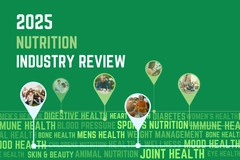
- Industry news
Industry news
- Category news
- Reports
- Key trends
- Multimedia
Multimedia
- Journal
- Events
- Suppliers
Suppliers
- Home
- Industry news
Industry news
- Category news
- Reports
- Key trends
- Multimedia
Multimedia
- Events
- Suppliers
Suppliers
A different beast? Rousselot reveals collagen bioavailability similar among various sources

11 Mar 2020 --- There are minimal differences between the bioavailability of four types of collagen peptides according to a study conducted by Rousselot, which simulated the transformation that collagen peptides undergo during human digestion and absorption. The research, which was performed in collaboration with research institutes in France and the Netherlands, also backs the ingredient supplier’s claim for the high bioavailability of its Peptan collagen peptide ingredient, as well as proposing a new way of scientifically measuring collagen bioavailability.
“This study takes a pioneering approach to capture the changes that Peptan undergoes while passing through our digestive tract and being absorbed into the bloodstream. It provides invaluable new data that contribute to build up our science knowledge behind the health benefits of collagen peptides, especially as part of Rousselot’s renewed strategic direction to invest in more fundamental research into the understanding of the mechanism behind Peptan’s health benefits,” comments Janne Prawitt, Scientific Director of Health and Nutrition at Rousselot.
Combining preclinical and clinical approaches, the study aimed to mimic the process of human digestion of four types of collagen from different animal sources that varied in molecular weight. In vitro digestions of the four collagen hydrolysates provided by Rousselot were performed with the model system tiny-TIM. The technology, which mimics the chemical, kinetic and dynamic conditions of human digestion, allows researchers to identify the nutrient fractions that are available for absorption in the small intestine, providing valuable information on the bioavailability of collagen peptides.
The French National Institute for Agricultural, Environment and Food Research (INRAe) performed a clinical test with 12 volunteers who ingested 25 g of collagen peptides. The serum collected after product intake allowed a reliable investigation of Peptan’s composition once absorbed by the body.
Minimal bioavailability differences between animal types
The results showed that although the collagen peptides underwent significant change during digestion and absorption, there were minimal differences between peptides of different sources once digested. The average molecular weight decreased as the different products were exposed to digestion enzymes and broken into smaller peptides. During this process, the products of different animal sources become more similar.
The human serum analysis revealed the presence of bioactive hydroxyproline-carrying dipeptides in the blood after Peptan ingestion. These dipeptides (Hydroxyproline-Glycine and Proline-Hydroxyproline) significantly contributed to the total increase of hydroxyproline, the characteristic amino acid of collagen, in the blood. Research organization Triskelion who contributed to the research, carried out a comparative analysis of the initial collagen peptides, their in vitro digests and the human serum, providing an overview of the composition of the collagen peptides before and after digestion and absorption.“
Research organization Triskelion who contributed to the research, carried out a comparative analysis of the initial collagen peptides, their in vitro digests and the human serum, providing an overview of the composition of the collagen peptides before and after digestion and absorption.“
The value of this study lies in the findings on the changing composition of the collagen hydrolysates. Such highly dynamic and complex products required the design of a novel (data) analytical workflow, which enabled us to compare different types of samples and obtain layered information. The insight gained with this approach was crucial for defining a suitable targeted setup. It’s extremely rewarding to lead the way with new scientific methods and to work with high profile partners,” explains Anne Kleinnijenhuis, Senior Scientist Analytical Research at Triskelion.
Collagen peptides have been shown to provide multiple benefits, especially in supporting skin, bone, sports recovery and joint health. However, in order to fully understand the cellular mechanisms responsible for those effects, it is important to map out the significant modifications that collagen peptides undergo when they pass the human digestion and are taken up by the body.
Both collagen and adaptogens are among the most preferred ingredients to be incorporated into food, driven by the ingestible beauty trend. A rise in collagen trends is driving interesting formats to deliver ingredients such as dissolvable granules and gummies.
Also in the collagen space, Geltor has developed an animal-free collagen using industrial fermentation and biodesign tools. The technology is said to be able to mimic human skin and be produced without animal inputs at any point in the production process.
Peptan was also at Rousselot’s stand at Nutraceuticals Europe last week, where NutritionInsight spoke to Gaëtan Noiret, EMEA Nutrition Commercial Director at Rousselot about the opportunities for the product.
Edited by Missy Green











